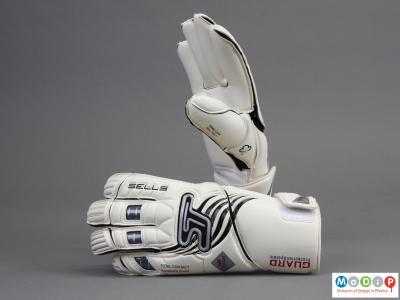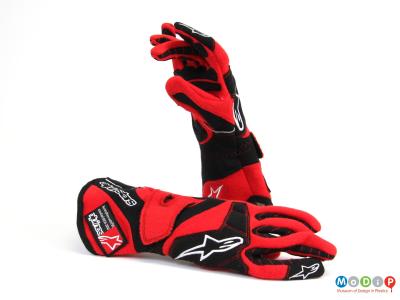Plastic-based materials used in the manufacture of sports gloves contribute to the wearer's performance, protection and comfort.
The blue seventy webbed gloves (1) are used for training for Ironman triathlons. The webs provide increased resistance to the water thereby building the swimmer's strength. They are made of flexible polychloroprene, better known by its Dupont trade name of Neoprene, a plastic-based rubber, which is soft and elastic as well as water resistant and insulating. It is also weather resistant. The Sells Total Contact Exosphere Guard H20 Goalkeeper gloves (2) feature Outlast® in their backs, a plastic-based, temperature regulating acrylic which absorbs, stores and releases heat as required. On their palms they have 4 mm of a proprietary form of latex which claims to have unsurpassed gripping qualities in wet weather. The Super 4 Contour Goalkeeper gloves (3) feature the same latex on the palm but the latex on the back is embossed with a punching zone of d3o®, a material with intelligent molecules. The molecules flow with you as you move but lock on impact absorbing the energy generated.
The Canterbury cricket gloves (4 - 5) were developed in 2006 by Teardrop Technologies to reduce injuries to batsmen's hands. Although the exterior is made, as is traditional, from leather, the interior includes a polyurethane bladder that can be inflated to suit each individual wearer and provide thus additional protection combined with a snug fit whatever the size and shape of the wearer's hand.
The Alpinestars racing gloves (6) are made of Nomex®, a flame resistant material consisting of an aromatic nylon developed by Dupont. Although first marketed in 1967, it is still used by most leading racing drivers. Normally light and flexible, it carbonises and thickens on exposure to intense heat forming a protective barrier between the heat and the skin.
The ability to keep water out while allowing moisture to escape is important for comfort. Gore-Tex®, patented in 1980, is an early example of such a membrane that is still widely used in sports apparel as in the glove (7). The membrane which has pores that are small enough to stop water penetrating but large enough to let water vapour out can be laminated to a range of materials to suit the characteristics required.







